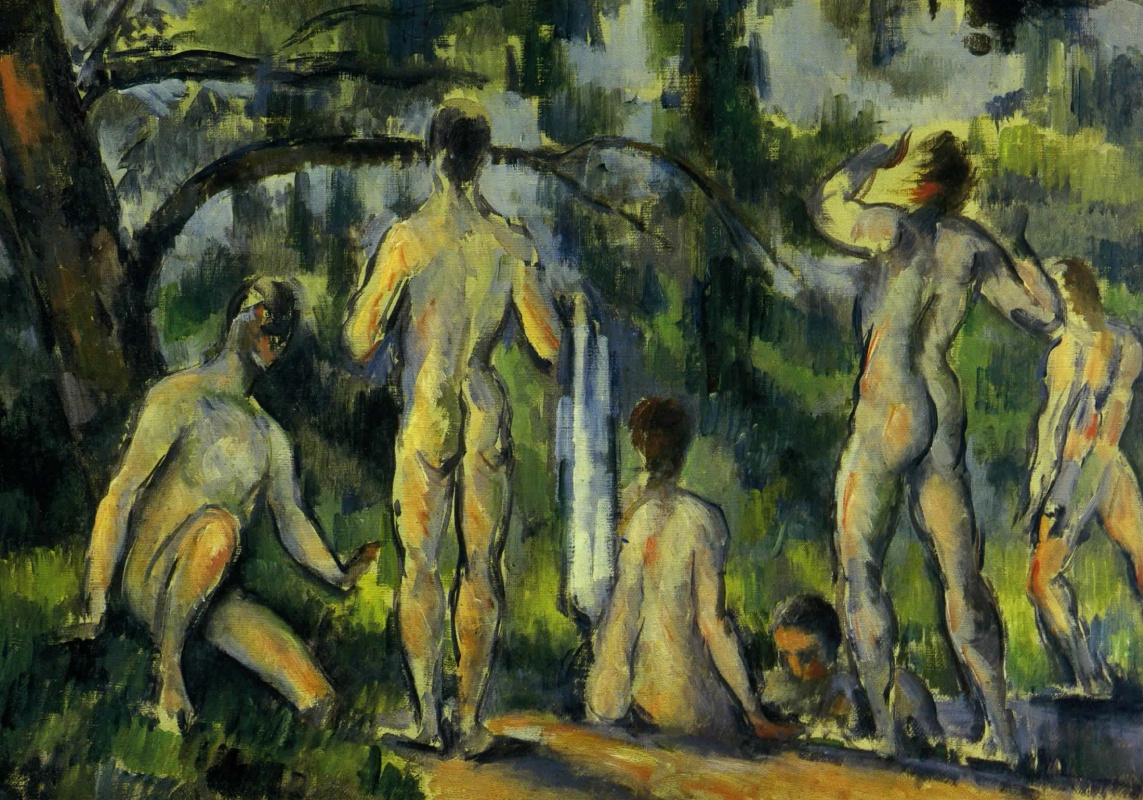log in
Enter site
Login to use Arthive functionality to the maximum
Bathing
Paul Cezanne • Painting, 1894, 26×42 cm
Description of the artwork «Bathing»
Paul Cézanne painted male and female bathers, both individually and in groups, about 200 times. He kept returning to this subject for 30 years, often considering finished paintings as unfinished and completing them in 5 or even 7 years from the moment he had began creating them. When Cézanne died, there was a painting "The Bathers" on his easel.
Having finally settled in Axe, Cézanne concentrates on seeking the picturesque truth of the Mount Sainte-Victoire and patiently puts ripe apples in a dramatic composition and then asks the gardener or local peasants to sit and pose for a long time.
But for the bathers, the artist takes youthful sketches of nudes out of the old folder - and these long-term observations and drawings are enough for him. Answering the young artists questions about the reason he doesn't use sitters, Cézanne smiles: he is too old to undress women. He arranges the figures on each new canvas the way an architect would create a plan for a modern building, using student studies of individual building elements.
The bathing scene is almost the only one Cézanne painted not from life but from his memory. And it was the only scene that meant a lot to the artist personally and connected him with the most valuable memories of his youth.
Thirteen-year-old Paul was the only student at the Collège Bourbon in Aix who did not mock the skinny, poor, frightened newcomer. The latter, who came to Aix from Paris, was called names and beaten up. Paul talked to him and they became friends. The newcomer's name was Émile Zola. It was a beginning of a long, bookish, musketeer friendship, full of adventures and tomfoolery. They read poems and dreamed of fame, serenades under the windows of the beloved ones, and of their future well off and honest life. In the meantime, they wandered all day long through the forests and mountains. They were called inseparable. In his book of memoirs Émile Zola wrote about those times: "In the summer we spent all the time at the river, almost lived there - bathing was our passion: we splashed in the water all day long and went ashore just to lie on the soft hot sand. " Throughout all adult life Cézanne collects the most valuable of his childhood memories into paintings, subject to strict compositional logic, and grows them anew.
Rhythmically alternating standing bathers with the seated ones, closing up the elongated figures of bathers into an even triangle, Cézanne sought to create a new art that could be compared with the works of old masters. Faceless male figures in paintings with bathers revive ancient power, confident grounding and, at the same time, divinity dissolved in the surrounding landscape.
Author: Anna Sidelnikova
Having finally settled in Axe, Cézanne concentrates on seeking the picturesque truth of the Mount Sainte-Victoire and patiently puts ripe apples in a dramatic composition and then asks the gardener or local peasants to sit and pose for a long time.
But for the bathers, the artist takes youthful sketches of nudes out of the old folder - and these long-term observations and drawings are enough for him. Answering the young artists questions about the reason he doesn't use sitters, Cézanne smiles: he is too old to undress women. He arranges the figures on each new canvas the way an architect would create a plan for a modern building, using student studies of individual building elements.
The bathing scene is almost the only one Cézanne painted not from life but from his memory. And it was the only scene that meant a lot to the artist personally and connected him with the most valuable memories of his youth.
Thirteen-year-old Paul was the only student at the Collège Bourbon in Aix who did not mock the skinny, poor, frightened newcomer. The latter, who came to Aix from Paris, was called names and beaten up. Paul talked to him and they became friends. The newcomer's name was Émile Zola. It was a beginning of a long, bookish, musketeer friendship, full of adventures and tomfoolery. They read poems and dreamed of fame, serenades under the windows of the beloved ones, and of their future well off and honest life. In the meantime, they wandered all day long through the forests and mountains. They were called inseparable. In his book of memoirs Émile Zola wrote about those times: "In the summer we spent all the time at the river, almost lived there - bathing was our passion: we splashed in the water all day long and went ashore just to lie on the soft hot sand. " Throughout all adult life Cézanne collects the most valuable of his childhood memories into paintings, subject to strict compositional logic, and grows them anew.
Rhythmically alternating standing bathers with the seated ones, closing up the elongated figures of bathers into an even triangle, Cézanne sought to create a new art that could be compared with the works of old masters. Faceless male figures in paintings with bathers revive ancient power, confident grounding and, at the same time, divinity dissolved in the surrounding landscape.
Author: Anna Sidelnikova


